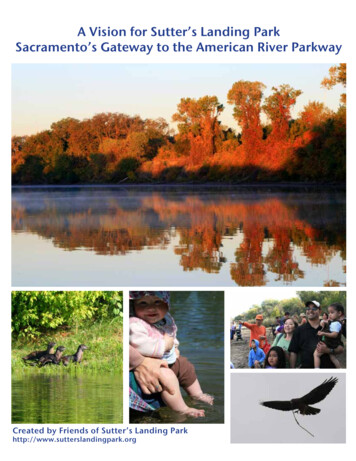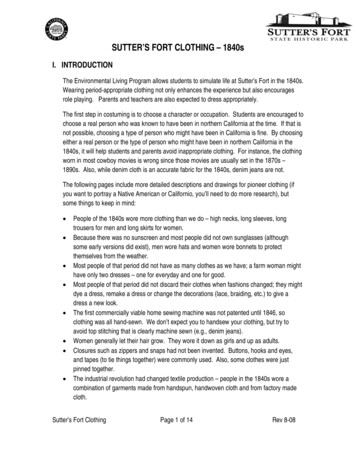
Transcription
A Vision for Sutter’s Landing ParkSacramento’s Gateway to the American River ParkwayCreated by Friends of Sutter’s Landing Parkhttp://www.sutterslandingpark.org
A Vision for Sutter’s Landing ParkCreate a welcoming and safe placealong the American River Parkwayat historic Sutter’s Landing Parkin Midtown Sacramentowhere families and individualscan relax, recreate, and enjoy the beautyand wonders of nature,both now and for generations to come.
The OpportunityNestled along the banks of the AmericanRiver about a mile northeast of downtownSacramento and less than three miles fromCalifornia’s State Capitol, Sutter’s LandingPark is a natural treasure in the heart ofSacramento. It serves as a historic gatewayto the 31.5-mile American River Parkway,which enjoys more than 8 million visitor daysper year—more than Yosemite NationalPark! With high population densities in thenearby adjacent neighborhoods of Midtown,Downtown, and East Sacramento, oneof Sutter’s Landing’s best aspects is itsaccessibility to city residents.Sutter’s Landing presents the opportunityof a nature park in the middle of the CentralCity, providing habitat for wildlife, as well asgreat access to trails along the American River forpeople. This 163-acre park currently offers a widevariety of other recreational opportunities, such as acovered skateboard park, a dog park, and the morerecently added basketball and bocce ball courts.Sutter’s Landing offers a unique opportunity toenhance the quality of life of residents today andfor future generations. The park could become alegacy project for the City of Sacramento, enrichingthe livability of our city and making it a destinationfor families, nature-lovers, and outdoor recreationenthusiasts.There exists an opportunity to add to the currentpark by widening the corridor along the river thatsupports wildlife, by expanding access for people toenjoy this resource through additional nature trails,and by helping inspire children and their familiesthrough increasing opportunities to learn aboutscience, nature, and the history of this importantsite.
LocationSutter’s LandingPark is a riparianand upland corridorof the AmericanRiver that serves asa buffer to the urbanenvironment whileproviding vital habitatand recreation forwildlife and people.
HistoryThe Nisenan, or Southern Maidu, were the originalinhabitants of this area. Traditionally, the ValleyNisenan lived along running water and traveledfrom place to place in boats made of tule reeds. Theythrived by hunting, fishing, and gathering food fromthe area.excavations resulted in the formation of large pits.Over time, the pits were filled in with garbagegenerated by the expanding city. The site becameknown as the 28th Street Landfill. It became thecity’s primary landfill, growing to become thehighest point in the City of Sacramento.In 1839, John Sutter and his men, after comingup the Sacramento River, landed at the northwestcorner of what would eventually become Sutter’sLanding Park. Shortly thereafter, Sutter establisheda permanent camp, and later built his fort at thecurrent site of Sutter’s Fort, the first settlementwithin the present city limits of Sacramento.After decades of use, the city first identified thelandfill as the site of a future regional park in1984. It was named Sutter’s Landing Park by theCity Council in 1989 and a Preliminary MasterPlan for Sutter’s Landing Park was adopted in1995. The City of Sacramento’s current approvedSutter’s Landing Park Master Plan was adopted inOctober 2003. Since then, a number of substantialimprovements have been made to the park.Soil was taken from the Sutter’s Landing areato build levees and elevate the city toprevent flooding. By the mid-1800’s, these
American River Parkway PlanThe first inklings of a parkway along the AmericanRiver date back almost a hundred years. As far backas 1915, the first possibility of a protected parkwayalong theAmerican Riverwas outlinedby the eminenturban plannerJohn Nolen.the county’s intent to preserve an open spacegreenbelt along the length of the American Riverin Sacramento County. The plan has been reviseda number oftimes sinceits adoption,including mostrecently in 2008.The primarygoal of the planis, “To provide,protect andenhance forpublic use acontinuous openspace greenbeltalong theAmerican Riverextending fromthe SacramentoRiver to FolsomDam.”Map of the 1915 American River Parkway Plan by John Nolen.In the late1940s, efforts fora parkway wereagain broughtforward byFrederick LawOlmsted, Jr.,the renownedplanner andlandscapearchitect andson of FrederickLaw Olmsted,Sr., the designer of New York’s Central Park.Olmsted emphasized the importance of some kind ofprotection for the river, including a parkway for the“Sacramento River and its Tributaries.”Naturalist Elmer Aldrich, of Sacramento’s RiverPark neighborhood, renewed efforts to create aparkway in the early 1950s. He envisioned a protectedrecreation area through the creation of the AmericanRiver Parkway. He called for the public purchase ofprivate land to form “an integrated park system forpublic enjoyment.”In 1962, the first American River Parkway Plan wasadopted in concept by Sacramento County, declaringThe riverfront area of Sutter’s Landing Park isincluded in the Woodlake Area Plan. WoodlakeArea Plan Policy 10.16 of the 2008 American RiverParkway Plan aims to:“Protect, enhance, and expand native habitats thatbenefit fish and wildlife species including creation ofseasonal wetland habitat, grassland restoration forraptor foraging habitat, and restoration of riparianand woodland habitat.”It’s time to further implement the vision of theAmerican River Parkway Plan in and around Sutter’sLanding Park.“The Parkway also provides a naturalistic ripariancorridor and open space greenbelt teeming with terrestrialand aquatic vegetation and wildlife. Beginning at theconfluence with the Sacramento River at the northern edgeof the City of Sacramento’s downtown core, the Parkwayprovides a refreshing respite from the pressures of urbanliving .the American River Parkway truly isthe Sacramento regional jewel.”— 2008 American River Parkway Plan, p. 240
Friends of Sutter’s Landing Park Objectives Keep it Wild! Restore and enhance wildlife values at Sutter’s Landing Park for the benefit of the wildlifeand the enjoyment, education and well-being of all who visit. Restore and enhance wildlife values on the land surrounding Sutter’s Landing Park by extending theboundaries of the American River Parkway to include additional land between the Capital City Freewayoverpass and the 17th Street Bridge (on the southern side of the American River), including willing selleracquisition projects. Create a safe and direct connection between Sutter’s Landing Park and the larger American RiverParkway via a new pedestrian and bike trail connector. Enhance recreational opportunities that are compatible with wildlife values. Incorporate environmental, historical and cultural educational features and activities within the park. Evaluate strategic locations within Sutter’s Landing Park which may be appropriate for green energygeneration, as long as:1. The construction and operation are non-disruptive to wildlife and habitat and are aestheticallyappropriate for the American River Parkway, AND2. A significant portion of the revenues generated through the leaseof the park’s land is directed toward wildlife habitat restorationwithin the park. Endeavor to make Sacramento’s Sutter’s Landing Park a model forconnecting urban families and individuals with nature.
The EcosystemDiverse communities of plants and animals coexistwithin the natural areas at Sutter’s Landing. Theriver attracts a wide variety of terrestrial andaquatic birds, mammals and other wildlife species.Riparian wetlands habitat provides food, waterand shelter for a wide variety of birds, mammals,insects, fish and plants that make their home here.The American River is the dominant element of thisecosystem and, along with shoreline and uplandhabitats, form a connected and interdependentsystem. Submerged plants provide food andshelter for many creatures. River otters den andforage near the river’s edge. Plant foods sustainturtles, crayfish and aquatic insect larvae. Acottonwood forest offers ideal nesting habitatfor the threatened Swainson’s Hawk, as well asmany other birds, mammals, butterflies and otherinsects. Nearby upland areas provide foraging formany species as well as cover and nesting for otherwildlife.Seasonal patterns in river level and flowfluctuations create changes throughout theyear, presenting different habitat conditions forthe plants and wildlife that rely on the area forsustenance and providing visitors with the ability toview an array of wildlife.
WildlifeThe diversity of wildlife making a home at Sutter’sLanding Park and nearby areas is surprising andimpressive, especially considering how close it is toDowntown Sacramento. The area provides a homefor wildlife that are at-risk, including Swainson’shawks (California Threatened species), white-tailedkites (California Fully Protected Animal), andnorthern harriers (California Species of SpecialConcern).snakes, fence lizards, skunks, ground squirrels,voles, and an occasional sea lion. Aquatic lifeincludes clams, crawdads, catfish, salmon, steelheadtrout, and other fish. Western pond turtles, the onlynative fresh-water turtle on the Pacific Coast, canbe found here along with the introduced red-earedslider.Visitors can also see river otters, beavers,jackrabbits, cottontails, coyotes, raccoons, gopherClockwise from top left: Blacktailed deer, birdwatchers, northernharrier, river otter, raccoon tracks;(center) red-tailed hawk with prey
BirdsRanging from shorebirds and waterfowl to raptors,a wide range of birds can be spotted at Sutter’sLanding, making it an excellent location for birding.Wood ducks, mallards, mergansers, cormorants,geese, pied-billed grebes, Swainson’s hawks(California Threatened species), northern harriers(California Species of Special Concern), white-tailedkites (California Fully Protected Animal), red-tailedand red-shouldered hawks, barn and great hornedowls, great blue heron, lesser and greater egrets,killdeer, western sandpipers, western meadowlarks,black phoebes, red-winged blackbirds, kestrels, ashthroated flycatchers, northern mockingbirds, beltedkingfishers, northern flickers,cedar waxwings, warblers,woodpeckers, Anna’shummingbirds, yellow-billedmagpies, sparrows, swallows,wrens, American goldfinches,mourning doves, robins, aswell as Lazuli buntings can allbe seen at various times of theyear, depending on migrationpatterns.Clockwise from top left: Common egret,Swainson’s hawks, birdwatchers, great blueheron; (center) spotted towhee
PlantsA variety of plants make their home along the riverat Sutter’s Landing, including cottonwood trees,elderberry bushes, non-native fig trees, box elders,at least three species of willows, sedges, mushrooms,and many more. Previous disturbances have allowedthe establishment of common non-native plants inareas. Some restoration work has been done throughFriends of the River Banks, with more planned tobring back a number of the native plant species.Clockwise from top left: Wildgrapes, honeybee pollinating nativeblackberry flowers, cattails, oakwoodland
Butterflies, Dragonflies, and MoreNumerous insects can be found at Sutter’s LandingPark, including at least 35 species of butterflies,dragonflies, ladybugs, bees and beetles. The valleyelderberry longhorn beetle, a federally threatenedspecies, can be found at Sutter’s Landing. Both thewestern tiger swallowtail and pipevine swallowtailbutterflies can be seen at Sutter’s Landing. Thepipevine swallowtail caterpillars feed only onDutchman’s pipe, a vine found along the AmericanRiver.Other types of invertebrates, not as showy as thebutterflies and dragonflies, are found in the waterand on land. These species play a critical role in thefood chain. Without them, the birds and mammalswould not exist here.Clockwise from topleft: Merganser familywith crayfish fordinner, damselfly, clam,looking at critters,exploring the river
Recreational OpportunitiesSutter’s Landing offers myriad opportunities for avariety of recreational activities for families and aplace for children to experience nature. Some of therecreational opportunities include: Interpretive/hiking trails that provideopportunities to view wildlife in their naturalhabitats Boat launch for kayaks, canoes, and other nonmotorized boats Dog park Photography Bird-watching Cycling Walking and jogging Spiritual practices such as meditation and tai chi Yoga Bocce ball Basketball Skateboard park Outdoor stage Restoration work Nature walks PicnickingFour photosabove: Existingrecreationalfacilities atSutter’s LandingPark includea large and asmall dog park,bocce ball court,basketball court,and a skateboardpark.
Educational OpportunitiesWith its proximity to a large population base,Sutter’s Landing presents a wonderful opportunityfor a range of educational programs, on topics suchas Native-American history, science, natural history,and living history, including programs for childrenthat focus on the natural and cultural history of theAmerican River Parkway. Sutter’s Landing offersthe space for educational programs that focus on theenvironment and on the importance of restoration,preservation, and conservation.
Restoration OpportunitiesOpportunities exist at Sutter’s Landing forimproving wildlife habitat through plantings ofnative species, thereby bringing back the area toa more natural state. Especially if additional landcan be brought into the park, the wildlife corridor Laurie Litman (3 bottom photos)could be widened and restored and the riversidehabitat could be increased, providing a wider andsignificantly more productive wildlife corridor forvisitors to enjoy.
Friends and SupportersThe following organizations, businesses, and individualssupport the Friends of Sutter’s Landing mission:B Street TheatreBoulevard Park Neighborhood AssociationCourtyard SchoolEast Sacramento PreservationFriends of the River BanksFriends of Grant ParkGarcia RealtyJoseph Cornell, author, Sharing Nature with ChildrenMarshall School New Era Neighborhood AssociationMcKinley East Sacramento Neighborhood AssociationMidtown Neighborhood AssociationMindset SoftwareNew Era Community GardenThai BasilHabitat 2020 Sacramento Audubon Society Save The American River Association (SARA) Sacramento Area Creeks Council California Native Plant Society - Sacramento ValleyChapter Friends of Swainson’s Hawk (FOSH) Save Our Sandhill Cranes (SOS Cranes) Environmental Council of Sacramento (ECOS)One of our partner organizations, Friends of the RiverBanks (FORB), offers free nature walks and activitieson the second Saturday morning of most months.Recent walks include an expert-guided talk aboutsubjects such as geology, mushrooms, birds, nativeplants, and dragonflies. For more information, visithttp://www.friendsoftheriverbanks.com.
Sutter’s Landing Park is a place where people canbask in the natural world within the hustle andbustle of our urban core. It is a place where childrencan play and absorb themselves in nature. It offerswildlife a home within our urban midst and a chancefor urbanresidents toconnect withnature. Theopportunity isthere to expandupon. Cecile MartinConclusion
Keep It Wild!There’s a stretch along the American RiverWhere nature’s beauty will set you free,There’s an oasis in the heart of Sacramento,A place our children love to be.Let’s keep it wild!We invite our community leaders to join usIn restoring wildlife values as we striveTo enhance Sacramento’s urban oasisSo that all life at Sutter’s Landing Park can thrive.Let’s keep it wild!It is time to connect with the river,As the honorable Nisenan people of the Maidu tribe would do,It is a constant source of wisdom,And of lessons, old and new.Let’s keep it wild!Now imagine our great grandchildrenPlaying along these historical shores,Laughing with the river otters,Watching the spectacular Swainson’s hawks soar.Let’s keep it wild!
Regional Attitudes AboutCivic AmenitiesJune 2017American River Parkway
Survey FindingsThe following pages offer an overview of key surveyfindings. The findings below are organized by:How much of a role do civic amenities play instrengthening our image outside the region?Menoo Values surrounding civic amenitiesWomenoo Priorities and preferences related to typesof amenitiesoo Use of existing amenitiesDemocrats0%oo Access to amenities and preferences ofpotential future amenitiesoo Investment prioritiesTo what extent do residents value civicamenities and what do they value mostabout our region’s civic amenities?Generally speaking, 91% of Sacramento arearesidents consider civic and cultural amenitiesimportant to their personal well-being and qualityof life. This finding transcends demographics andillustrates that civic amenities are a criticallyimportant component of people’s lives.When asked how important civic amenities are toresidents’ quality of life, respondents said:Strong role20%40%Moderate role60%8%ModeratelyImportantSlightlyImportantNot at allImportantSimilarly, 95% consider amenities important for theimage of Sacramento to people living outside theregion. Democrats and women tend to feel morestrongly about this.Valley Vision June 2017120%No role at allHow important are civic amenities to attractingvisitors to the Sacramento region? Howimportant are they to enticing individuals andfamilies to relocate to the region?50%Very Important68%37%25%11%6%Not at all Important1%100%About 87% of residents consider public amenitiesimportant for attracting visitors to Sacramento,while 93% consider amenities an important factorfor individuals and families to relocate to theregion. Again, Democrats and women felt morestrongly about this.Slightly Important37%80%Minimal roleModerately ing Individuals & Families40%60%80%Attracting VisitorsA smaller but still large percentage (80%) consideramenities important for attracting businesses tothe region – even more so among women andthose of lower socioeconomic status.6
How important are civic amenities to enticingbusinesses to relocate or grow here?44%When asked to rank the least important type ofamenities to quality of life, respondents said:Spectatorsports venues36%16%VeryImportantModeratelyImportantLive theater4%SlightlyImportantNot at allImportantCivic amenities are a crucial part of both people’sdaily experiences and a source of identity andvalue to the region as whole.What are residents’ priorities andpreferences across different civicamenities?When asked to rank the single most importantcivic amenity to their quality of life, respondentssaid:54%Science andhistory museums9%Music venues8%Art galleriesand museums7%Events andfestivals7%Recreationalsports facilities6%Live theater6%Spectatorsports venues0%9%Music venues9%Science andhistory museums7%Art galleriesand museums7%1%5% 10% 15% 20% 25% 30% 35% 40% 45%There were some ways that preferences for types ofamenities changed across different demographics:oo Younger men tend to be more supportive ofspectator sports venues, and recreationalsports facilities. In general, men tend tobe more supportive of history/sciencemuseums.oo Live theater tends to be more importantto older whites, whereas community eventsand festivals tend to find greater favoramong younger people, women, andnon-whites.oo More specifically when it comes to festivals,music/visual arts/cultural heritage festivalstend to be more important amongDemocrats, non-whites and those of lowersocioeconomic status.4%10%11%Community events,parades, festivals0%Survey respondents indicated their preferences fordifferent types of amenities. A major finding wasthat residents overwhelmingly view parks and trailsas the most important amenities, both in termsof their own quality of life and in terms of publicinvestment.16%Recreationalsports facilitiesParks andTrailsParks andTrails40%20%30%40%50%60%oo The trends described above in terms ofpreferences for different types of amenitiestend to hold for residents’ perceptions ofthe region as a whole and for their specificcommunities.On the other hand, respondents tend to viewspectator sports facilities as the least important.Valley Vision June 20177
How do residents use existing amenities?When asked about the purpose of publicamenities, 91% of residents expressed thatamenities should promote the values of the region,while 96% of individuals indicated that amenitiesshould provide a pleasurable escape fromday-to-day stress.Survey respondents indicated their use patterns forexisting amenities in the region:oo Of the available public amenities, mostresidents visit and use urban parks andgreenbelts, the American and Sacramentorivers, and Old Sacramento while themajority of people indicated that theydid not use the Papa Murphy’s Park, theSacramento Softball Complex, and theThree Stages at Folsom Lake College in thelast two years.oo Democrats were more likely to say that civicamenities should be educational, whileRepublicans were more likely to say thatthey should be “family friendly”.oo Democrats are generally more likely touse civic and cultural amenities, especiallymuseums, art galleries and performing artsfacilities. Exceptions to this rule includeparks/trails and spectator and recreationalsports facilities.The following table shows frequency of use ofexisting amenities. Amenities are ordered by mostfrequently used to least frequently used. “NA”indicates that the respondent is not familiar withthat amenity.Urban parks and greenbeltsThe American and Sacramento RiversOld SacramentoThe American River ParkwaySports fields in my neighborhoodCal Expo and California State FairFolsom LakeCalifornia State Capitol/Capitol GroundsCrocker Art MuseumThe Sacramento Zoo, Fairytale Town, FunderlandGolden 1 CenterRaley FieldThe Music Circus and Sacramento Theater CompanyCalifornia State Railroad MuseumThree Stages at Folsom Lake CollegeThe Mondavi Center for Performing ArtsOpera, symphony, balletPapa Murphy’s ParkSacramento Softball Complex0%FrequentlyValley Vision June 2017Occasionally20%Rarely40%60%Never80%100%120%NA8
When asked why respondents visit the amenitiesthat they do, they responded:oo Majority of residents visit the AmericanRiver Parkway, American River, SacramentoRiver and Folsom Lake because of recreational activities, accessibility, proximity,cost, and the natural environment.oo Residents visit the Old Sacramento HistoricDistrict for accessibility, shops, history,restaurants, trains, and other availableactivities. Additionally, it is convenient forfamilies and pets.To what extent do residents haveadequate access to amenities and whatare the barriers?67% of respondents consider most publicamenities universally accessible to people in theircommunities. However, respondents’ views aboutaccessibility changed according to their incomelevels.oo More higher-income respondents viewedamenities as accessible than lower-incomerespondents.oo Those who enjoy the Capitol Grounds gofor its hosted events. This is also similar forthose who visit Cal Expo and the State Fair.oo Golden 1 Center and Raley Field areenjoyed for sports and concerts. Similarly,neighborhood sports fields are widelypopular for young children and recreationalactivities.oo Residents enjoy local parks, urban parksand greenbelts because of cost, accessibility, recreational activities and wellness.oo The Sacramento Zoo, Fairytale Town, andWilliam Land Park are enjoyed by manyfamilies because of their appeal to children.oo The Crocker Art Museum and the MondaviCenter are not widely visited, but residentsgo for visual and performing arts.oo Although rankings reflect less popularity,Three Stages at Folsom Lake College isvisited for its proximity, plays, music andconcerts.To what extent do you agree or disagree thateveryone in your community has equal access tothe amenities they wish to visit?Less than 50K62%39% 50K- 100K69%31%More than 100K72%28%0%20%Agree40%60%80%100% 120%Disagree85% of respondents agreed that cost was alimiting factor influencing their decision to usepublic amenities.oo 18-39 year olds, those making lessthan 50K, those with less than a BA,non-whites, and women were most likely tocite cost as the most prohibitive factor.Valley Vision June 20179
oo Transportation issues, such as parking,distance, traffic, and access to transportation were also cited by a majority ofrespondents.How should investments be prioritized andwhat role should government and privateinvestors play?Not surprisingly, 90% support greater publicinvestment in amenities -- especially Democrats,those who are younger, and those of lower socioeconomic status.When asked the degree to which government hasa role in funding/investment, respondents said:50%40%Moderate Role2%Minimal RoleNo RoleWhen asked the degree to which the followingamenities should have more local investment,respondents replied:56% respondents said that parks and trailswere most in need of investment when asked toprioritize investment needs.Parks, trails andrecreational areas53%WaterfrontdevelopmentCulturalattractions andcommunity eventsMost in need of investmentParks, trails andrecreational areas56%WaterfrontdevelopmentCulturalattractions andcommunity events14%12%Theater andmuseums9%Venues thatshowcase the arts6%Sports andentertainmentvenues3%0%8%Strong RoleWhen asked why parks, trails, and recreationalareas need more government investment,respondents said:32%37%34%25%33%Theater andmuseums24%35%Venues thatshowcase the arts21%35%10%20%30%40%50%60%oo These venues do not generate economicgrowth, therefore, need support from thelocal government.oo They are important to preserve theenvironment and its natural resources.oo Parks and recreational areas are criticalfor promoting health, well-being andcommunity involvement.oo Investment to these venues will make theregion more appealing and attract visitors.oo These venues are accessible to allindividuals and are free for residents to visit.oo Parks, trails, and recreational areas arepopulated by the homeless, therefore, needto be maintained and cleaned.oo Current conditions of parks and recreational areas are not safe.Sports andentertainment 7% 16%venues0% 10% 20% 30% 40% 50% 60% 70% 80% 90%Much moreA little moreValley Vision June 201710
Respondents recognized that civic amenitiesare important enough to support from their ownpocketbook. When asked which type of amenitiesthey would be most likely to support by payinghigher taxes, respondents ranked them in thefollowing order:1Parks and Recreational Areas2Museums3Cultural Attractions (tied with #4)4Theaters (tied with #3)5Arts and Entertainment Venues6SportsA majority of people across most demographicswould pay 21-30 in increased annual taxes.46% of respondents making under 50K would“probably” or “definitely” support a tax at thatlevel.A majority of people across most demographics wouldpay 21-30 in increased annual taxes.Less than 50K46%55%54% 50K- 100KMore than 100K46%66%0%20%40%Definitely or Probably Yes35%60%80%100% 120%Definitely or Probably NoTo access the full survey report go gion-civic-and-cultural-amenities-survey.To see the demographic make-up of the panel, seeAppendix A.Valley Vision June 201711
landfill as the site of a future regional park in 1984. It was named Sutter's Landing Park by the City Council in 1989 and a Preliminary Master Plan for Sutter's Landing Park was adopted in 1995. The City of Sacramento's current approved Sutter's Landing Park Master Plan was adopted in October 2003. Since then, a number of substantial










